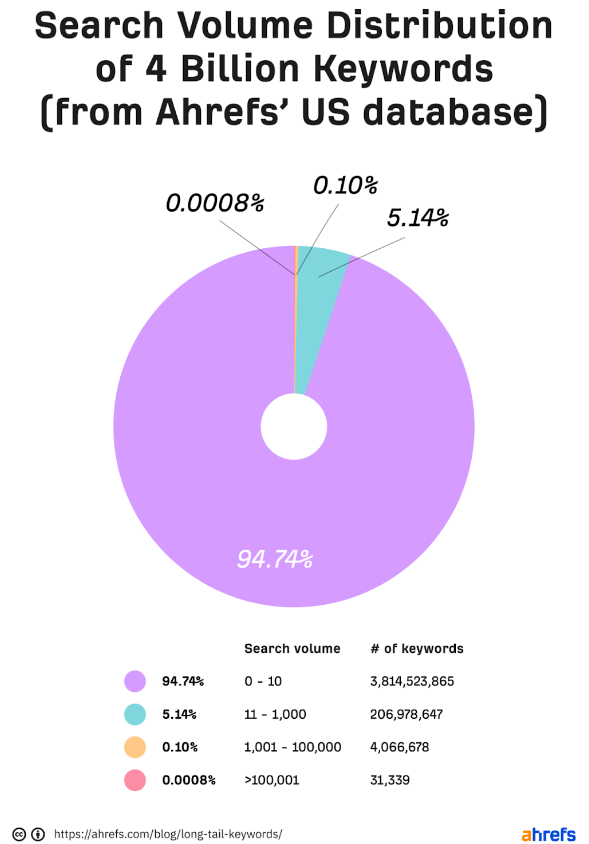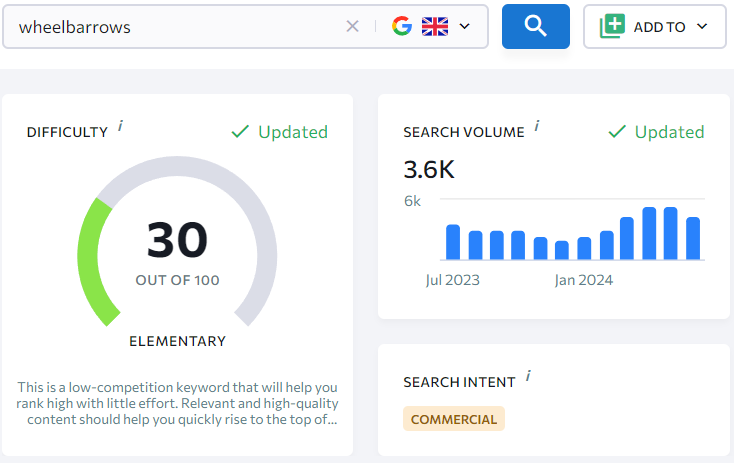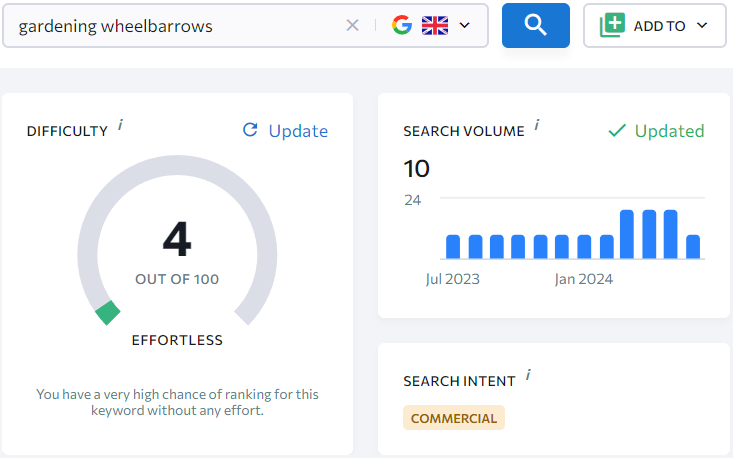Using low search volume keywords can be an invaluable asset to any marketing strategy, here’s why:
Increased Relevance: Although the search volumes can be very low, they are quite specific and worth targeting anyway. In fact, it has been reported that 56% of buyers use queries of three or more words when searching for something online, so you might be missing out on a lot of conversions by not including long tail keywords in your content.
High Conversion Rates: Much like the previous point, relevant terms could convert better than keywords with higher search volumes.
Low Search Difficulty / Competition: They tend to have less competition, making it easier for your website to rank higher in SERPs.
Great Return On Investment: As long tail keywords tend to be more specific to what searchers are looking for, they tend to have a more actionable intent. As a result, searchers are more likely to convert when performing a search for these queries.
Competitor Analysis: When looking for long tail queries that are relevant to your business, it’s important to look at what type of content your competitors are writing about. If they aren’t making use of long tail keywords, using them in your own content can be an easy way to appear above your competitors in the search results page.
The image that we’ve added below from Ahrefs shows that 95% of all keywords have 10 or fewer monthly searches, which tells us that a significant chunk of traffic comes from low search volume keywords. By targeting these terms, we can help you to tap into a niche audience and increase your chances of attracting potential customers who are genuinely interested in your products or services.

When conducting keyword research, it can be easy to exclude zero search volume keywords. However, it’s important to remember that there are some additional elements to consider, aside from just looking at search volume at face value:
Inaccuracies In Keyword Research Tools: Keyword research tools are based on historical data and don’t accurately reflect real-time searches. For example, there won’t be any historical search data for news and new events, but it could be extremely relevant and important.
Emerging Trends: Much like the previous point, it’s important to consider what is happening in your industry. If you can see an emerging trend that could be relevant to your business, becoming an early adopter of publishing content about the emerging trend will help you get seen.
Lack of Ad Triggers: Many keyword research tools use ad triggers as a baseline for how many searches it perceives the keyword to have. Although using a low search volume keyword with low ad triggers isn’t recommended in paid advertising as it reduces how often your ad can be shown for that keyword, it can be beneficial for SEO. By using low search volume keywords in your SEO strategy, you can create content that is relevant to your target audience and provides an opportunity to attract organic traffic without the competition of paid advertisements.
Using keyword research tools like SEMrush and SE Ranking, we can pinpoint the type of content that users expect to see when searching for a specific keyword.
By targeting high-intent keywords, we can attract potential customers who are further down the sales funnel to increase your chances of them converting. These keywords are often less competitive and have a higher chance of driving qualified traffic to your website.
When conducting keyword research, we will consider the intent of the keyword when suggesting copy. For example, if a keyword has transactional or commercial intent, we would suggest copy to include the keyword and its variations, as well as using terms like ‘buy now,’ ‘shop online’ or ‘get a quote’.
We sometimes find that there are opportunities for our clients to target keywords that their competitors haven’t targeted. Whilst we recommend focusing on using relevant keywords with a good search volume for visibility, integrating low search volume keywords can broaden your audience reach.
Let’s take wheelbarrows as an example. As you can see from the images below, ‘wheelbarrows’ has a search volume of 3,600, whereas ‘gardening wheelbarrows’ only has a search volume of 10. Although wheelbarrows have a much higher search volume, it is considerably more difficult to rank for.
When creating copy for pages that focus on these terms, we would suggest focussing on wheelbarrows as the primary keyword, with ‘gardening wheelbarrows’ being used where relevant on occasion. This way, you’re not excluding low competition, highly relevant keywords in your copy.


Due to the rise of Google’s AI Overviews, searches are becoming more and more conversational between searchers and search engines. This trend further highlights the importance of using long tail, question-based keywords in your content, despite their low search volume.
For example, let’s say you were a pet supplies eCommerce business. Before AI overviews were introduced, users might’ve searched for a simple term like ‘dog food’. Now, you will probably see more long tail searches like ‘what is the best dog food for my labrador?’
Although ‘dog food’ has an extremely high monthly search volume and shouldn’t be ignored, specific long tail searches have a much higher relevance than broad keywords. When conducting keyword research for your websites content, always consider the question-based searches as these are terms that people are actively searching for and content is likely to be very thin on that specific topic.
As mentioned in the previous sections, using low volume keywords in your content can increase your contents visibility and reach. Here are some best practices for effectively incorporating keywords into your content strategy:
As an eCommerce website, you could use relevant, high search volume keywords for your category headings and long tail keywords could be used within your category copy, FAQ content or blog articles.
Strategically using a combination of high and low volume keywords throughout your content is essential for optimising your SEO efforts. Here are some best practices for effectively placing low volume keywords in your content:
Meta Description: If possible and relevant, you can include low volume keywords in your meta description after your main keyword. For example, you could mention something like ‘Shop a range of wheelbarrows, including farming, construction and gardening wheelbarrows to suit your needs.’
Headings: Where relevant, you can incorporate low volume keywords in the headers of your content.
Content Body: This is the easiest way to incorporate low search volume keywords as you’re not limited by characters. Incorporate these keywords in a way that reads naturally and isn’t over-optimised where it’s used too much in the content.
Low search volume keywords are often overlooked but are a game changer when it comes to elevating your online visibility. If you’re interested in making the most out of low-competition keywords, drop us a line. Our team of specialists are on hand to conduct thorough keyword research, identify opportunities and make suggestions to optimise your SEO performance.
